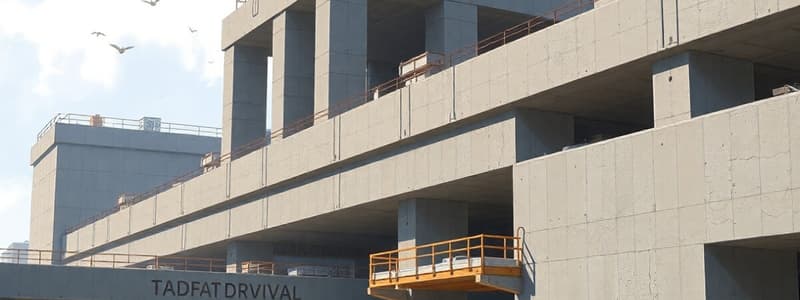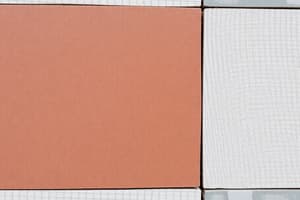Podcast
Questions and Answers
Which of the following is the primary reason steel is often coated with paint or galvanizing in construction?
Which of the following is the primary reason steel is often coated with paint or galvanizing in construction?
- To prevent corrosion. (correct)
- To increase its tensile strength.
- To improve its weldability.
- To reduce its weight.
Why is the water-to-cement ratio a critical factor in concrete production?
Why is the water-to-cement ratio a critical factor in concrete production?
- It directly impacts the hydration of cement and thus the strength and durability of the concrete. (correct)
- It affects the color of the final concrete product.
- It only affects the workability of the concrete mix.
- It primarily influences the size of aggregate that can be used.
When selecting wood for a construction project that requires high resistance to decay and insects, which treatment method would be most effective?
When selecting wood for a construction project that requires high resistance to decay and insects, which treatment method would be most effective?
- Applying fire-retardant coatings.
- Treating with chemical preservatives. (correct)
- Kiln drying the wood.
- Applying a coat of varnish.
Which type of masonry bond is characterized by alternating courses of headers and stretchers?
Which type of masonry bond is characterized by alternating courses of headers and stretchers?
Which of the following is a key benefit of using laminated glass in building design?
Which of the following is a key benefit of using laminated glass in building design?
What is a primary concern associated with the increased use of plastics in building construction?
What is a primary concern associated with the increased use of plastics in building construction?
What does 'embodied energy' refer to when evaluating the sustainability of building materials?
What does 'embodied energy' refer to when evaluating the sustainability of building materials?
How does the addition of steel reinforcement improve the structural performance of concrete?
How does the addition of steel reinforcement improve the structural performance of concrete?
Which material property is most indicative of a building material's ability to withstand scratching and surface damage?
Which material property is most indicative of a building material's ability to withstand scratching and surface damage?
What is the significance of 'k' value in the context of building materials?
What is the significance of 'k' value in the context of building materials?
Flashcards
Concrete
Concrete
A composite material made of cement, aggregates, and water that is strong in compression but weak in tension. Often reinforced with steel.
Steel
Steel
An alloy of iron and carbon, known for its strength, ductility, and weldability, used in structural frames and reinforcement.
Wood
Wood
A natural composite made of cellulose fibers, lightweight and renewable, used for framing, flooring, and finishes.
Masonry
Masonry
Signup and view all the flashcards
Glass
Glass
Signup and view all the flashcards
Plastics
Plastics
Signup and view all the flashcards
Embodied energy
Embodied energy
Signup and view all the flashcards
Density
Density
Signup and view all the flashcards
Thermal conductivity
Thermal conductivity
Signup and view all the flashcards
Strength
Strength
Signup and view all the flashcards
Study Notes
- Building involves designing, planning, and assembling materials for structures or infrastructure.
- Buildings offer workspace, storage, and shelter
- Infrastructure refers to roads, bridges, and utilities.
Building Materials
- Building materials are chosen for their properties, availability, and cost.
- Common building materials are steel, concrete, masonry, wood, glass, and plastics.
Concrete
- Concrete consists of cement, aggregates, and water
- Cement is the binder
- Aggregates, like sand and gravel, offer strength and bulk.
- Hydration of cement requires water
- Concrete excels in compression but is weak in tension.
- Concrete's tensile strength is improved using steel reinforcement.
- Reinforced concrete sees widespread usage for bridges, buildings, and foundations.
- Cement types can alter concrete properties, including chemical attack resistance and setting time.
- Admixtures boost concrete's workability, durability, and other characteristics.
- Concrete's properties depend on mix ratios, material quality, and curing conditions.
- Concrete is both durable and versatile.
Steel
- Steel, a carbon and iron alloy, is strong, ductile, and weldable.
- Steel is used for cladding, concrete reinforcement, and structural frames.
- Steel types have different strengths and properties.
- Carbon steel is the most common type.
- High-strength steel suits high-strength applications.
- Stainless steel resists corrosion and is used in exposed settings.
- Coatings like paint or galvanizing protect steel from corrosion.
- Steel is recyclable.
- Steel is an essential modern construction material.
Wood
- Wood is strong, lightweight, and renewable, composed of cellulose fibers.
- Wood is used for sheathing, finishes, flooring, and framing.
- Softwoods, like fir and pine, are used for framing.
- Hardwoods, like maple and oak, are used for finishes and flooring.
- Wood requires treatment with preservatives because it is susceptible to decay, insects, and fire.
- Fire-retardant treatments exist for wood.
- Wood is sustainable if harvested responsibly.
- Engineered wood products are oriented strand board (OSB), laminated veneer lumber (LVL), and plywood.
Masonry
- Masonry is building structures from units bonded with mortar.
- Bricks, concrete blocks, and stone are common masonry units.
- Mortar contains cement, sand, and water.
- Masonry offers good insulation and is strong in compression.
- Masonry walls can be load-bearing or non-load bearing.
- Masonry is durable and fire-resistant.
- English bond, stack bond, and running bond are types of masonry bonds.
- Masonry veneer is a thin layer applied to a building's exterior.
- Masonry needs skilled labor for proper installation.
Glass
- Glass, made from silica, can be translucent or transparent.
- Glass is used for curtain walls, doors, and windows.
- Glass allows natural light into buildings.
- Float glass is the most common type.
- Tempered glass is stronger than annealed glass.
- Laminated glass has a plastic interlayer bonding two or more glass layers.
- Insulating glass units (IGUs) consist of multiple glass panes separated by airspace.
- Reflective or low-E coatings on glass can reduce heat loss or gain.
- Glass is recyclable.
Plastics
- Plastics are synthetic polymer materials that are lightweight, versatile, and durable.
- Plastics are used for roofing, piping, insulation, and cladding.
- Polyvinyl chloride (PVC) is a common piping plastic.
- Polyurethane (PU) is used for insulation.
- Plastic recycling rates vary by plastic type.
- Some plastics release volatile organic compounds (VOCs), which can affect indoor air quality.
- Plastics use in construction is increasing.
Other Building Materials
- Other materials are roofing materials, insulation, copper, and aluminum.
- Aluminum is lightweight and resists corrosion.
- Copper is used for piping and electrical wiring.
- Insulation reduces heat transfer.
- Roofing protects buildings from the elements.
- Project requirements dictate material selection.
Sustainability of Building Materials
- The sustainability of materials is increasingly important.
- Sustainable building materials have a low environmental impact.
- Recyclability, resource depletion, and embodied energy should be considered.
- Embodied energy is the energy to transport and produce a material.
- Resource depletion is the consumption of resources.
- Recyclability is a material's ability to be recycled.
- Recycled materials, straw bales, bamboo and wood, are examples of sustainable materials.
- Green building rating systems, like LEED, promote using sustainable materials.
Material Properties
- Mechanical properties govern response to forces.
- Strength is the ability to withstand stress without breaking.
- Stiffness measures resistance to deformation.
- Elasticity is the ability to return to original shape after deformation.
- Density measures mass per unit volume.
- Thermal properties dictate a materials behavior under different temperatures.
- Thermal conductivity is the ability to conduct heat.
- Specific heat capacity is the amount of heat required to raise the temperature of a unit mass of material by one degree.
- Durability is the ability of a material to withstand wear, weathering, and other forms of degradation over time
- Water resistance is the ability to resist penetration by water
- Chemical resistance is the ability to resist degradation by chemicals
Studying That Suits You
Use AI to generate personalized quizzes and flashcards to suit your learning preferences.




